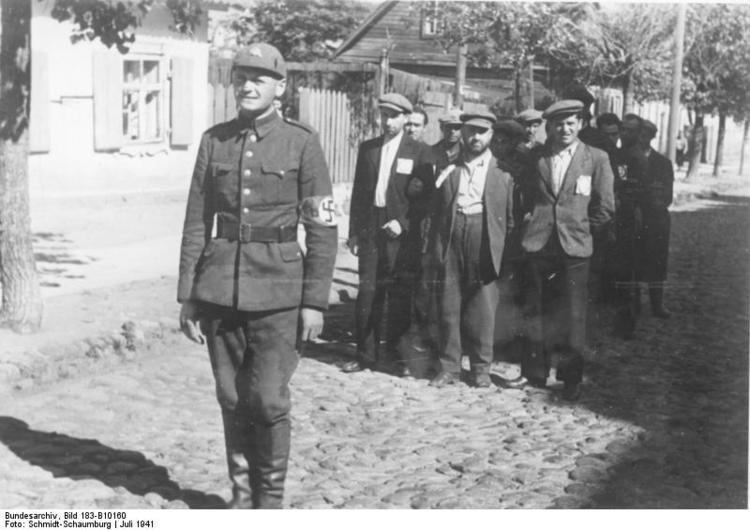 | ||
The Lithuanian Auxiliary Police Battalions were paramilitary units (battalions) formed during the occupation of Lithuania by Nazi Germany between 1941 and 1944. Similar units, known as Schutzmannschaft-Bataillonen, were organized in other German-occupied territories of Eastern Europe. In Lithuania, the first battalions originated from units formed during the anti-Soviet Uprising of June 1941. Lithuanian activists hoped that these units would become the basis for the reestablished Lithuanian Army. Instead, these units were absorbed into the German military apparatus and aided German forces: guarded strategic objects, engaged in anti-partisan operations, participated in the Holocaust. The 12th and the 13th battalions, tracing their roots from the Tautinio darbo apsaugos batalionas (TDA), were particularly active in the executions of the Jews and were responsible for estimated 78,000 Jewish deaths in Lithuania and Belarus. While the battalions were often deployed outside of Lithuania, they generally did not participate in combat. In total, 26 battalions were formed and approximately 13,000 men served in them. In July–September, 1944, the remaining units were combined into two Lithuanian Volunteer Infantry Regiments.
Contents
Terminology
The units are known under a number of different names. German documents referred to them as Ordnungsdienst (order service), Selbstschutz (self-defense), Hilfspolizei (auxiliary police). From September 1941, they became known as Schutzmannschaft-Bataillonen (abbreviated Schuma; police team). In Lithuanian, the police battalions were known as savisaugos batalionai (self-defense battalions), apsaugos dalys (security units), Lietuvos apsaugos dalys (LAD, security units of Lithuania).
Formation
In June 1940, Lithuania was occupied by the Soviet Union. The Soviets introduced harsh sovietization policies, including nationalization of larger enterprises, landholdings, and real estate. Opponents of communism and the new regime were persecuted: an estimated 6,600 were imprisoned as "enemies of the people" and another 17,600 deported to Siberia. The Lithuanian Army was reorganized into the 29th Rifle Corps (179th Rifle and 184th Rifle Divisions) of the Red Army. More than 500 of Lithuanian officers were retired and 87 were imprisoned.
When Nazi Germany invaded Soviet Union on June 22, 1941, Lithuanians greeted the Germans as liberators from the repressive Soviet rule. They spontaneously joined the anti-Soviet June Uprising, formed the Provisional Government of Lithuania, and declared restoration of independence. Lithuanians began forming their own military and police units in hopes to recreate the Lithuanian Army. The territory of Lithuania was invaded by and divided between two German Amy Groups: Army Group North, which took over western and northern Lithuania, and Army Group Centre, which took over most of the Vilnius Region. Therefore, developments in Kaunas and Vilnius were parallel but separate.
The first battalion, known as the Tautinio darbo apsaugos batalionas (TDA), was formed by the Provisional Government of Lithuania in Kaunas on June 28. The Provisional Government dissolved itself on August 5, 1941. The battalion was not dissolved and German Major Franz Lechthaler took over its command. On August 7, when TDA had 703 members, Lechthaler ordered the battalion to be reorganized into two battalions of auxiliary police (German: Polizeihilfsdienst bataillone; Lithuanian: Pagalbinės policijos tarnyba or PPT). During August three more battalions of PPT were formed. In October, these five battalions were renamed to security battalions (Lithuanian: apsaugos batalionas). In December, the five battalions were reorganized again into battalions of Schutzmannschaft.
Lithuanian men massively deserted from the Soviet 29th Rifle Corps and gathered in Vilnius. They organized Lithuanian Self-defense Units (Lithuanian: Lietuvių savisaugos dalys or LSD), stationed in Vilnius, Pabradė, Trakai, and Varėna. On July 21, 1941, LSD was reorganized into Vilnius Reconstruction Service (Lithuanian: Vilniaus atstatymo tarnyba or VAT) that had three units (Work, Order, and Security). On August 1, VAT and its three units were reorganized into three battalions of Schutzmannschaft. Two more battalions were organized before October 1941.
